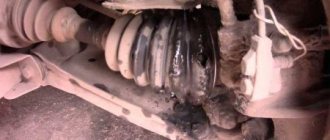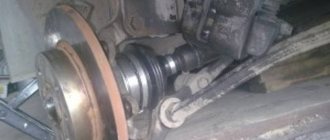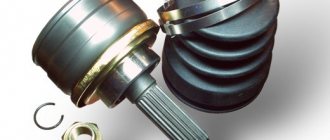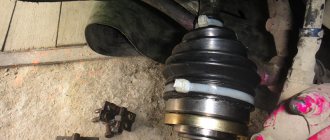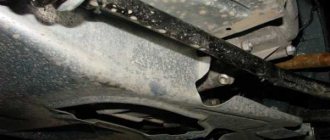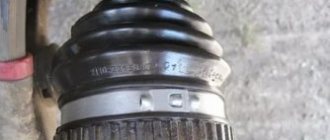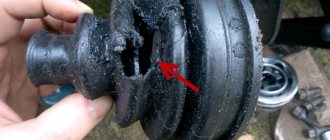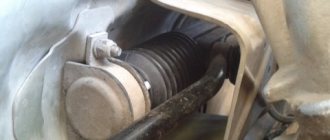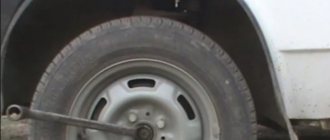#RTI_products #replacement_boot_viburnum #wear_boot #reason_for_boot_wear #signs_of_wear #replacement_hinge_protection
Lada Kalina is a front-wheel drive car, the engine and gearbox are located across the body. The main gear drives the wheels. CV joint - a constant velocity joint (popularly called a “grenade”) provides torque. There are several such hinges in the Lada Kalina (internal and external). A common reason for repairing Kalina is replacing the CV joint boot, which quickly wears out and breaks.
What is CV joint
The abbreviation CV joint stands for constant velocity joint, which ensures the transmission of torque from the gearbox to the wheels. People call the CV joint a grenade because of its purely visual similarity.
Thanks to its design, the CV joint allows the wheels to rotate at different angles up to 70 degrees. The CV joint itself is protected by a boot. If the machine is used for a long time, for example, several years, the rubber boot of the CV joint becomes unusable, tears and cracks appear, the lubricant gradually leaks out and mixes with dirt. To prevent the CV joint itself from breaking, which simply cannot tolerate sand and dirt, it is necessary to check the condition of the boot from time to time, and, if damage is detected, replace it in time. Otherwise, this may lead to breakdown of the CV joint itself, and its replacement will be more expensive. For those who are going to replace the CV joint boot for the first time, I advise you to watch this video:
Basic information about LADA Kalina
LADA Kalina has been produced since 2004; production of the popular second-generation car began in 2013. Kalina-1 is available in three body types: hatchback (model 1119), sedan (model 1118), station wagon (model 1117). There are cars available with petrol engines of three modifications: a 1.4-liter 16-valve engine with a power of 89 hp. s., 1.6-liter 8-valve engine producing 81 hp. s., 1.6-liter 16-valve engine producing 98 hp. With. The LADA Kalina-1 has only a manual transmission with five gears. The front axle has a classic MacPherson suspension, the rear axle has a beam with stabilizer, springs, and shock absorbers.
Typical faults of LADA Kalina-1
Significant malfunctions with Kalina rarely occur, but there are a lot of various undesirable trifles. The car’s clutch is not very reliable and has an impressive service life, regardless of the type of engine, so it can malfunction after 40-50 thousand kilometers. The main source of malfunction is a broken clutch disc.
You need to constantly monitor the oil level in the engine - sometimes it leaks through the gaskets or burns through the piston rings. On the instrument panel there is only an oil pressure warning light, but there is no dial indicator. If the indicator lights up all the time, there is a possibility that the crankshaft is knocking.
A common malfunction of VAZ gearboxes is increased noise. It is difficult to get rid of the humming of the gearbox; sometimes neither replacing the bearings nor refilling with first-class transmission oil comes to the rescue. The transmission is noisy even in new cars, because of this the Volzhsky Automobile Plant has repeatedly completed the transmission.
A problematic element since the days of the VAZ 2108 and VAZ 2109 has been the thermostat in the engine, moreover, the valve in the thermostat was capable of jamming in any position. It's annoying when the engine doesn't heat up to the required operating temperature, but if the engine overheats, it's more problematic.
Electrical problems on LADA Kalina appear mainly of three types:
- the ignition module is often damaged;
- very soon the bearings and diode bridge “die”;
- The window lift cable on the driver's door breaks.
When the ignition coil sparks, the first and fourth cylinders or the second and third cylinders stop functioning. The ESP cable breaks when it falls off the guides.
The main source of cracking noise in outer CV joints is insufficient lubrication; At the factory, in order to save money, they put it in sparingly. The consequence of this is severe wear of the hinges, and as a result, the “grenade” needs to be replaced.
A broken timing belt is a very annoying problem. And if on the 8-valve engine 21114 it is possible to change the belt drive and move on, then on engines 11194 or 21126 the valves bend from the oncoming push from the pistons, repairs will be quite expensive. In addition, a break can occur through a jammed water pump, because of this, if the pump begins to make noise, it must be replaced immediately.
How to determine that the CV joint boot needs to be replaced?
The method is simple: you need to go to the pit and inspect the boot; if it is dry and no traces of oil are visible, then everything is in order and replacement is not required yet.
If, after checking, you find that there is a malfunction and a replacement is needed, then you will need the following tools: 1. Jack, hammer, wooden block; 2. Keys for 17 and 30; 3. Mount, balloon; 4. Flat screwdriver, special pliers for installing clamps; 5. New boot + CV joint grease, graphite grease, kerosene or similar flushing fluid.
There is a situation when, during a sharp start, a single knock or crunch is heard in the area of the front wheels. Most likely, you are already too late and will have to change the CV joint itself.
Checking the visual condition of the boot
Visual inspection of the outer grenade boot - everything should be clean. No traces of grease, dirt or cuts.
Damaged boot in grease. This needs to be changed urgently. Otherwise, the CV joint (grenade) will need to be replaced.
How to replace the CV joint boot on a Lada Kalina
In order to simplify the replacement of the CV joint boot, it is better to carry out the work on the removed axle shaft.
- Tighten the handbrake and place chocks under the rear wheels. It is very important that the machine is parked on a level surface.
- We take the balloon and begin to remove the wheel. Don't rush to jack up the car; remove the bolts while the car is standing on four wheels. After this, you can jack up one side on which the work will be done. It is dangerous to work on a jack, so be on the safe side and place a block or metal jack under the car.
- If there are wheel arch liners, use a screwdriver to pry up the protective cap and remove them.
- We place a container under the drain hole of the gearbox, unscrew the plug and drain the transmission oil.
- Now we unscrew the fastening bolts, thanks to which the ball is attached to the steering knuckle - there are two of them.
- Unscrew the hub nut. To do this, you need to fix the hub; to do this, just press the brake pedal. Here you need to ask someone to press the brake pedal.
We need to get the thrust washer, this is not difficult to do, after which we turn the wheels to the extreme position (this depends on which side the replacement is happening from) and carefully squeeze the outer CV joint out of the hub. To prevent the drive shaft from falling, it is better to hang it with a piece of wire.
8. Using a pry bar, with one hand we press the inner CV joint out of the box, and with the other hand we hold the drive shaft itself.
Important note! If you need to remove both drive shafts, you should insert the old CV joint into the box before pressing the second shaft in its place. If you do not do this, the alignment of the side gears will be disrupted, after which you will not be able to install the drive shaft.
- Now comes the most painstaking work where we will need a vice. We take the drive shaft and fix it in a vice. Using a screwdriver, remove the old clamps and cut off the old anthers if they are damaged. If they are still suitable for use, there is no need to cut them.
- Next, using a hammer and a soft metal or wood socket, knock the outer and inner CV joints off the drive shaft.
Assembly
The new boot is placed on the axle shaft. The places where the parts come into contact should first be well treated with lubricant. The grease must also be pressed into the grenade itself. Then:
- install the bearing on the axle shaft using a hammer and a wooden block;
- remove excess air from the boot and tighten the clamp;
- put on the steering knuckle;
- tighten the hub nut using a torque wrench.
Now all that remains is to tighten all the wheel nuts and lower the car from the jack.
With a new bearing you can safely drive 250-300 thousand kilometers. However, the condition of the boot can significantly reduce this distance. Due to the fact that dirt, sand and water get inside, the lubricant becomes like an abrasive, which slowly but surely destroys the bearing.
Now you know how to replace the boot on Kalina. This can easily be done by one person in one and a half to two hours using ordinary tools. But to guarantee quality repairs, we advise you to contact specialists.
How do you understand that the CV joint boot needs to be replaced?
Well, let’s finish this brief excursion and move on directly to the troubleshooting process, but first, prepare the tool.
You will need:
- Jack, hammer, wooden block;
- Keys to “17”, “30”;
- Mount, spray can;
- Flat-head screwdriver, special pliers for installing clamps;
- New boot + CV joint grease, graphite grease, kerosene or similar flushing fluid.
Gearbox lever rattling
For LADA Kalina, a typical malfunction is rattling in the area of the gearshift lever, which mainly becomes noticeable when the engine is running at speeds of about 3000. The source of the side sound is the bushing, which is made a little thicker than necessary, and because of this, a gap appears in the mount. To resolve this problem you need to do the following:
- remove the handle cover, which is attached with latches;
- using two 13mm wrenches, unscrew the nut and bolt;
- remove washers and bushings;
- to eliminate rattling, the bushing in the middle needs to be slightly sharpened in width or the mount should be lubricated with sealant;
- Having done this, mount everything back. The sealant does not help out every time, but if you sharpen the bushing by 0.3 mm, the result is guaranteed.
It’s safe to say that repairing a Lada Kalina car yourself is not so scary. Every car enthusiast has the opportunity to eliminate minor malfunctions of this car. You just need to believe in yourself, follow our advice and everything will work out!
Replacement of internal and external CV joints - affordable price, impeccable quality
In a car service, replacement of CV joints, internal and external, is carried out with a minimum of discomfort for the car owner: quickly and at an affordable price. Carrying out such a responsible operation as replacing the outer or inner CV joint on a car, our craftsmen guarantee the exceptional quality of the work performed and the spare parts used.
Replacing a CV joint (replacing a grenade) - the design and principle of operation of this unit
CV joint - or constant velocity joint - is a device that transmits torque from the differential to the wheels. The CV joint consists of the following parts:
- Frame;
- Separator;
- Clip;
- Balloons;
- Clamps;
- Retaining rings;
- Protective cover (dust boot).
The spherical body has grooves for the balls, just like the CV joint cage. The cage is designed to hold the balls in position (just like any regular bearing). Thanks to its design, this joint can transmit rotation at almost any angle of deflection of the shafts (up to 350 degrees), and transmit it evenly. The boot also protects the internal surfaces of the hinge from moisture, dust and dirt, which increase friction and prematurely wear out this unit.
Disassembly algorithm
When a decision is made to dismantle the outer CV joint for replacement, proceed according to the following scheme:
- Using a gate extension, the wheel bolts are torn off and the hub nut is unscrewed.
- The car is lifted off the floor with a jack.
- The wheel is dismantled.
- The fastener of the ball joint is unscrewed.
- Having turned the steering wheel as much as possible, you need to press the steering knuckle and remove the hub with the hinge. In this case, you can help yourself a little with a hammer.
- The damaged protective cover and clamps are removed from the grenade.
- To dismantle the CV joint, special equipment is used. If it is missing, the hinge can be knocked down with gentle blows of a hammer.
Repair methods
We have already found out that the main malfunction of the grenade is associated with a torn and damaged boot.
Accordingly, in order to fix the problem, you need to do something with this casing, which is shaped like a cone.
In the case of doing the repair yourself, there are 2 options:
- Emergency
. It is carried out when a breakdown catches you on the road. Literally in the field, it is necessary to partially reanimate the CV joint and its boot. In this case, the CV joint boot is not even fully replaced without removing the CV joint. But the method is still useful for emergency situations; - Garage
. Here you are already in the garage, you have a set of tools, a pit or even a lift at hand. Some are sure that there is no way to do without removing the hinge. It's a delusion.
Now we will talk about each repair method separately.
Both options can be used on various vehicles, be it:
- VAZ 2110;
- Lada Kalina;
- Renault Logan;
- VAZ 2114;
- Lada Priora;
- Chevrolet Niva (Shniva);
- VAZ 2115;
- Lada Granta, etc.
Yes, it is generally better to conduct such experiments on domestic cars, as well as on budget foreign cars. Their design is simpler, and spare parts are not so expensive if you suddenly need to correct your own mistakes.
But the price of a professional service for replacing the boot is quite impressive. This is another reason to do everything yourself.
How the malfunction manifests itself
The Lada Kalina CV joint is a unit designed to work in extreme conditions. Accordingly, this device has a solid margin of safety and high-quality protection from adverse factors - a boot made of durable rubber, hermetically isolating the mechanism from the external environment. If the car undergoes maintenance on time and is carefully maintained by the owner, and is used on good highways, then both external and internal CV joints work flawlessly for a long time, without causing any complaints.
When the car is used to travel over rough terrain, where potholes are common, the hinges, which experience extreme loads, can be damaged. In addition, the breakdown of this functional unit may be due to other circumstances:
- production errors;
- use of material that does not meet technical requirements;
- use of low quality lubricant;
- clogging of the internal space.
If the owner of the car begins to hear a metallic grinding, clicking or crunching noise while driving along the highway, you should check the integrity of the boots and the functionality of the outer and inner CV joints at the first opportunity. If any of the components fails, it is completely replaced.

